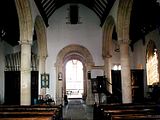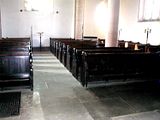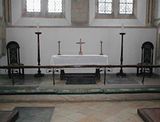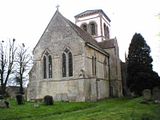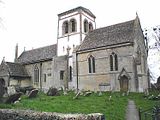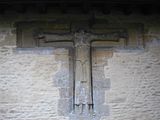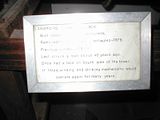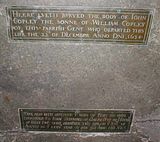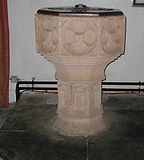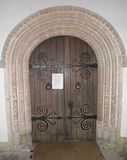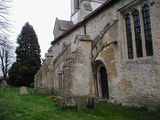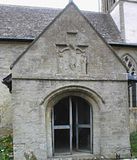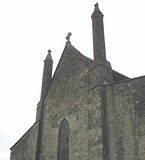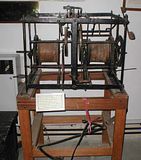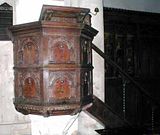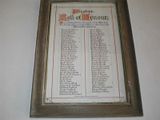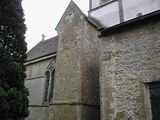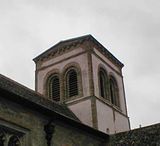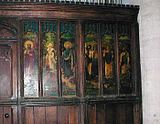About the Church
The Building of St Matthew's Church
Even though St Matthew's is said to be the oldest church in the area, it is probably the second church built in Langford. In the 10th century the spiritual needs of the people living in the south-west corner of Oxfordshire between the rivers Windrush and Thames and the Gloucestershire border were catered for by a 'minster' - a group of monks established for the purpose - at Bampton (six miles East of Langford). Early in the 11th century, however, Langford and Broadwell, which together included the area of the present parishes of Kencot, Filkins, Broughton Poggs, Little Faringdon and Kelmscott and were held by the Earl of Mercia, had been established as separate 'parishes'. By the mid 11th century Langford had been transferred to the Earl of Wessex, later King Harold. It is probable that one or other Earl would have built a church or chapel. Nothing remains of this earlier church, if it existed, except possibly the sculptures discussed later.
A new church was built about 1080, probably by /Elfsige of Faringdon, using Saxon masons, though there is evidence of Norman influence in some aspects of the design, especially in the parapet and corbel table of the tower, which appear to date from about 1200; perhaps the roof, which may then have included a small wooden spire, blew off in a storm and it and the damaged parapet had to be replaced. /Elfsige was a Saxon who, in 1066, held two hides (about 80 acres) near Longworth, the other side of Faringdon; in 1086, however, he held 50 hides, 38 of which, including all 15 at Langford, had previously been held by King Harold himself. Apart from the fact that he had clearly made himself useful to the Normans, and been rewarded accordingly, we know nothing more of /Elfsige; perhaps he had been a local administrator, or possibly Harold's factor for the area.
If the tunnel-vault inside the tower (ground-floor) is original, it is one of. only three Saxon stone vaults in the country. However, it is more probably a 13th century insertion as there is a cross bay to accommodate a window in the south wall, which is stylistically of this date; also the original east and west doorways in the first floor chamber of the tower are now 3 ft higher than the present stone floor.
In late Norman times, the nave was rebuilt in Norman style, giving us the present magnificent Norman arches. In the 13th century, the chancel was rebuilt on a larger scale, the side aisles were either added or modified, and the turret stairway to the belfry was added, together with the porch. The short sections of the north and south aisles that overlap the tower, and now contain the organ and the vestry are probably later additions.
The west windows of the nave and aisles are 13th century lancets, as is the round-headed window at the east end of the south aisle (hidden by the organ). The other windows are Decorated and Perpendicular; the one in the south aisle between door and vestry is a fine early 14th century example, while the square headed windows west of the nave doorways in both aisles are 15th century
In the 15th century a nave clerestory was inserted above the line of nave pillars and the nave was re-roofed.
in the time of the first Elizabeth, major work was done on the church; one of the two buttresses on the north side bears the inscription "ANNO DMI 1574 REGN ELIZABETH DECIMO SEPTIMO". The two peculiar, apparently purposeless, pillars on the gable of the West wall appear to date from this period, or possibly earlier in the same century. At some stage the chancel seems to have been poorly restored. It was also probably shortened by at least one bay at the same time, as the priest's door (now filled in) is too far east. The east wall also seems to have been demolished and rebuilt rather clumsily, as the mouldings and shafts of the east window no longer fit together properly in places. During the 16th to 18th centuries the population of the country, and of individual villages, grew rapidly, and it was probably in response to this that a gallery (apparently of wood) was erected in the West end of the church; this ran across the full width of the building and came forward almost as far as the first pillars. In 1829, presumably in response to a further increase in population (it was then 50% greater than at present) the church was reseated; the gallery was rearranged to seat 100, there were benches for 94 in the centre aisle, and there were box pews all round the sides and back of the church and in front of the pulpit, where the nave altar now stands. A grant of £80 towards the cost of this was
received from the Incorporated Society for Promoting the Enlargement and Repairing of Churches and Chapels; a wooden plaque commemorating this hangs in the porch.
A drawing in the Bodleian Library, dated 1861, shows the chancel with a very shallow-sloped roof, and the 15th century nave clerestory with decorative 'battlements' that completely conceal the low-pitched roof behind them. However, in 1864 or 1865, the church was again re-roofed and the clerestory removed. In a letter, written in 1866, the then vicar refers to the completion of "the throwing up of the roof to its original Early English pitch"; this is the present roof. Changing the pitch of the roof also required the east and west walls to be built up again (they must have been reduced in height when the roofs were lowered earlier). The marks of two earlier roofs can still be seen on the east wall of the tower in the chancel; the very prominent smaller mark is probably that of /Elfsige's roof, to judge by its size.
This reroofing was part of more extensive work undertaken between 1864 and 1867. The additional small lights and unusual window heads above the lancet windows in the chancel were probably part of these works, but some authorities think they are original; there is similar work at Wyck Rissington in Gloucestershire. In addition, the 'unsightly gallery' (the then vicar's words) was removed, a vestry was established in the South Aisle chapel and the box pews of 1829 were replaced by the present open seating; rural populations were falling as people left the villages to work in the new factories
The tower was restored in 1995. In addition to the works mentioned above, the church structure must have been repaired or modified several times, but we have no documentary evidence of these occasions.'
The Interior of the Church
The entry to the church is through the south porch. The mouldings of the late transitional doorway are without bases or capitals and consist of three recessed members, that in the centre being filleted. The hood above the arch consists of nail head moulding terminating in masks. Six impressive circular pillars divide the nave from the aisles and support semicircular arcades, whose double roll moulding with a deep hollow between is rich in effect. The capitals are remarkable for their diversity of design and depth of undercutting. Their present good condition suggests that at some period they have been restored (possibly in the 1860's, though this is not recorded).
The 15th century carved oak screens which now enclose the vestry and organ chamber were moved from elsewhere in the church, probably the chancel. The painted panels attached to the screens depicting various saints connected with the history of the church are modern; they were painted and presented in 1943 by Clifford Pember, a local artist. The twelve figures fall into three groups. First there is St Matthew, the patron saint of this church, together with SS Mark, Luke and John, who had the joy of writing the gospels. Then three missionary pioneers in this land; SS Augustine, Patrick and Birinus, founder and first Bishop of the See of Dorchester. And finally the local saints: St Christopher, the patron saint of the village school, St Friedswide, the Patroness of the University, City and Diocese of Oxford, St Edmund, a Berkshire boy who later went to Oxford, St Hugh, who was Bishop after the diocese was moved from Dorchester to Lincoln, and a 19th century saint, Edward King, Bishop of Lincoln.
The fine Jacobean pulpit was made in 1673 by Thomas Whiting for £8. It was probably originally a double-decker. In 1865 it was proposed to discard the pulpit and provide a new one, until someone removed the "mean boards" with which it was then covered, and revealed the fine carving. The inappropriate pedestal and mean stairway were provided in 1867; the old stair descended into the tower, while the new one gives access directly from the vestry, which was considered more convenient.The octagonal font is 15th century.
There used to be a priest's chamber over the porch, but heavy replastering in the 19th century has entirely obscured the access, and left only meagre traces of the staircase which led to it; the lower part of this staircase may have been wooden, or even a simple ladder, protruding into the south aisle.
Beneath this is the Howse memorial tablet with its punning inscription. John Howse was churchwarden in 1691, and is reputed to have lived in the house standing to the north of the village war memorial
The pilaster on the south side of the nave arch, behind the pulpit, has been cut away to make a niche, which may have held a piece of statuary; the central portion of the upper stone has been cut back as if to admit the head of a figure. Was this the site of "the image of St George newly made for Langford church" for which, by his will proved at Lambeth on 18th October 1467, Henry Richard Fermore bequeathed 10 marks, "and to complete the pavement and renew the seats here"? It is not known what happened to this figure, possibly it fell prey to the Puritans.
The jambs of the chancel arch have a large semi-circular shaft and a smaller one at the interior angle. The base is of three members each chamfered. The caps are plain chamfered with a neck mould and an abacus of a plain chamfer. The arch is semi-circular of the same section as the jambs, without any hood. This arch has probably taken the place of an earlier one, and may date from the rebuilding of the chancel in the 13th century.
In the chancel there is a 13th century piscine, inserted into the blocked up opening of the sanctuary door at the east end of the south wall; it has a trefoil head of deeply cut mouldings, finished on both faces, and foliage enriching the flanking piers. There is another small piscina just to the west of the door. Opposite this on the north wall, there is an unusual 13th century Perpendicular aumbry of three gables and six compartments. The large number of compartments may indicate that the church was at one time rich in relics or plate.
Over each arch of the tower is a rectangular headed opening into the second storey of the tower - the bell-ringers chamber. Both were once blocked up, but that into the nave has been re-opened.
Beneath the altar in the chancel is a fine brass engraved with the figures of Walter Prunes, and his wife Mary. It is inscribed:
Here lyeth the bodyes of Walter Prunes of Langford in the county of Berks, gent. and Mary his wife, daughter of Toby Playdell of Great Farrington in the said county. He deceased the 25th day of Februarye 1594, she deceased the 29th day of March 1609.
There is a similar inscription, but referring only to him, on the back of a brass memorial to some children of the Whistler family in Goring church. It is probable that this covered his grave originally and was replaced when she died and was buried beside him.
On the north side of the same altar is a well worn Purbeck slab with two inscriptions, not now fully legible. However, records show that the first, in Roman capitals, reads:
Here lyeth buried the body of John / Copley the sonne of William Copley / of this parrish Gent who departed this life the 22th of October Anno Dni 1634
Below it there is a second inscription, rough cut in script:
Here also lyeth interred ye body of Mary his wife Daughter to John Stephens of Colchester is ye county of Essex Esq who departed this life on ye xxith of August in ye Ixxvth year of her age Anno Dni 1665
The Exterior
At the north-east corner of the tower a 13th century square turret, with a saddle back roof, contains the staircase that provides access to the upper stages of the tower. An ingeniously inserted door provides access also to the chancel.
The richly moulded cornice on the south wall is remarkable for its deep undercutting and for the triple heads which form a stop at the south-east angle.
In the centre of the north and south faces of the two lower stages of the tower are pilaster strips about a foot wide of genuine 'long and short' work, very regular below, but higher up the longs vary in length. Such strips are characteristic of Anglo-Saxon buildings.
Other pilasters of smaller stone ashlar work embrace the corners of the two upper stages like early Norman clasping buttresses, but these are now thought to be replacements inserted in the 15th century or even later
Inserted in the pilaster on the south face at the second storey is a slab upon which are carved in low relief two men with bare heads and sharp pointed beards, clad in short skirts or kilts and close fitting upper garments. Behind them are lines of drapery suggestive of cloaks. They support upon their raised arms the flat semi-circular disc of a sundial. In 1886 part of the iron gnomon could still be seen, but this has now completely corroded away; nor can the form and arrangement of the numerals be now determined.
The second stage is pierced on both north and south walls by Saxon double-splayed windows in which the aperture is cut in a key-hole shape in a mid wall slab.
Each face of the tower is pierced at the third stage (the bell chamber) by a pair of louvred lights with semi-circular heads of roll mould. The joints pass through all moulds and not through each mould separately as in Norman work.
The Sculptures
The south porch carries Langford's most notable and interesting treasures, the Crucifixion with Figures and the Langford Rood. Both of these figures date from before the Norman Conquest and so are older than the church. They have therefore been brought here from elsewhere; this might have been the earlier Langford church - if it existed. It is possible that they were commissioned by Earl Leofric of Mercia, known to be a notable patron of the arts.
The Crucifixion with the figures of Our Lady and St John, all carved in limestone, have clearly been reset and the frame altered and partly renewed. The arms of the Christ have been transposed so that they hang down - a man being crucified hangs from his arms, which therefore go up; if they were the right way up, the arms would not fit into the space available. The figures have also been transposed because they now look away from the Cross, and the Virgin was always depicted on our Saviour's right and St John on his left. It is probable that this is no more than the result of uneducated masons trying to reassemble the figures within the gable end.
The principal figure is carved in high relief on four stones; the head and upper part of the body are on one stone, the lower part and the legs on another, and each of the arms is on a separate slab, the four slabs forming a cross. The symbolism is probably deliberate. The head, which has short wavy hair, is inclined to the right shoulder and bent forward. Behind it is a circular disc having a cross patee slightly relieved on it. The loins are covered by a kilt in folds reaching to the knees, which are slightly inclined to the right. The feet are separate and resting on a sloped pedestal, the toes pointing outwards.
The character of this Crucifixion, which is thought to date from between 1020 and 1040, is not merely due to primitive or clumsy rendering, but to a definite iconographical tradition, that of the early Church in Syria and Palestine, which regarded Christ as a suffering human being rather than a divine figure whom pain could not touch. The sculptor may well have visited, or come from, the Middle East.
The Langford Rood, as the fully robed figure of Christ in majesty now set in the eastern wall of the south porch is known, is unique in England. The figure, all of limestone, has lost its head and it seems that this would not have fitted into the space now occupied by the broken stone above. It is uncertain therefore whether it was crowned or not. The legs are straight and the feet are separate, resting on a sloped pedestal and apparently shod. No nails can be seen in either the hands or the feet. The sleeves, which extend to the wrists, where they widen and fall open, and the lower part of the robe down to the ankles are carved in folds. On the breast immediately below the neck the stone is deeply pitted in a semicircle; this may suggest enrichment in the form of a collar, or it may be due to weathering or the blows of the hammer which destroyed the bearded face during the 'Great Pillage' in 1547 ordered by the Commissioners of Edward VI. Around the waist is a girdle crossed in front through a ring.
The Rood is thought to be pre-Norman. The method of construction supports this view, notably the jointing of the four stones of which it is formed. The two vertical stones above and below the arms are rebated into the two horizontal pieces, which themselves abut with a vertical joint central with the figure. This is a carpentry technique applied to stone. It is paralleled elsewhere in pre-Conquest work; for example at Bitton in Gloucestershire and at Britford in Wiltshire
The Bells
Note: For safety reasons visitors are not admitted to the bell-chamber. With one exception the present bells were cast in 1741, by Henry Bagley III, probably at his Witney works. The Great Bell of the previous set had cracked in that year, and it was ordered at the annual Visitation, that they should be replaced by the next Visitation.
In 1953 the tenor bell was recast and a new treble bell was cast and added to the set as a memorial to Sydney Reading, Vicar's Churchwarden for 30 years.
The Prebends of Langford Ecclesia and Langford Manor When Langford was first established as a parish it was part of the then Diocese of Dorchester (a few miles south of Oxford), but the Normans soon transferred the seat of the diocese to Lincoln. Two of the prebends established in Lincoln Cathedral, were Langford Ecclesia and Langford Manor; a prebend was land or other holdings the income from which was used to support a canon of a cathedral. Consequently, when, with the growth of population, several smaller dioceses were created from Lincoln, Langford remained a 'Peculiar', i.e. a parish that was located in one diocese (Oxford) but was administered by another (Lincoln). The prebend of Langford Ecclesia carried with it the advowson of Langford (the right to present candidates to fill a vacancy in the living). It became the custom for the Canon Prebendary to lease out all the lands attached to the Prebend, together with the advowson, for a period of three lives in return for an annual income; in 1805 this was £20. In 1812, the then Prebendary departed from the usual custom and split the prebend into five leases, each for three lives; one of these was a lease solely of the advowson, for a rent of £1 per annum. In 1855, the living fell vacant and the then lessee presented the Rev Francis G Lemann for the living. However, by this time the situation had been regularised and the parish was now under the authority of the Bishop of Oxford, who refused to recognise the lessee's right to present a candidate. There was a legal case, which was finally settled, out of court, by the Bishop accepting Mr Umann on this occasion, and the lessee relinquishing the right to present any further candidates. Reading the hand-written records of the case is complicated as Mr Lemann's lawyer was Mr Leman.
The Village in History
In the 13th and 14th centuries, Langford was quite an important place in the district. We have details of the taxation valuations of 1291 and 1341, when in Bampton Hundred only Bampton and Burford had higher valuations. In 1291, the Parish was valued at £60 (a large sum for the period), the Vicar's holding at £5 and the Lay Prebend at £40. In 1341, the parish was again assessed at £60, but the Vicar's holding was zero-rated, and the Lay Prebend at only £3.13.4; there is a note in the records that the assessment was low because the fields were
"exhausted and unsown" and there had been high mortality among the sheep. By contrast, nearly 200 years later, in 1524, the parish was assessed at only £18, the vicar at £21.19.4 and the Lay Prebend at £20, and even these lower figures were reduced because of the prevailing conditions to £13.6.10, nothing and £15.14.0.
Although Langford may seem a quiet country backwater, two battles have been fought within its confines. Both were fought because of the importance of the ancient Radcot Bridge (King John paid for its repair in 1208) at the eastern end of the parish as a crossing of the Thames - for many centuries the first above Oxford.
In December 1387 Henry Bolingbroke and the'appellant lords' defeated the army of Richard II in a skirmish here, which led to Richard's submission to the rebel lords the next year. A few years later Bolingbroke became Henry IV.
During the Civil War, the Royalists garrisoned Radcot Bridge as one of the outer defences of their capital at Oxford. During the final phases of the war, a Parliamentary force surprised the garrison and took 200 prisoners.
Langford and Neighbouring Parishes
Langford has always had a close relationship with the smaller village of Little Faringdon, about a mile to the south. Indeed, until the thirteenth century, the area now called Little Faringdon was actually part of Langford. Then King John endowed the Abbey of Bello Loco (now Beaulieu) in the New Forest with lands at Faringdon and the southern part of Langford; the latter soon became known as Little Faringdon.
Despite this secular separation, it remained a chapelry of the Parish of Langford until 1860, although the relationship seems at times to have been a prickly one; many of the annual Visitation reports in the seventeenth and eighteenth centuries record complaints by the churchwardens that the men of Little Faringdon had not been paying their share of the upkeep of the church and churchyard.
In 1860, Little Faringdon was elevated into a parish in its own right, but was re-united with Langford in 1964, when the same priest was inducted as vicar of both parishes. In 1988 both were united with the parishes of Kencot, Broadwell, Filkins cum Broughton Poggs and Kelmscott to form the Broadshire Group served by a common vicar, and in September 1994 the Group was itself combined with the Shill Valley Group to form the present United Benefice, covering the whole south west corner of Oxfordshire.
These sites cover the ox18 area of Oxfordshire England, including the following villages, OX18, Alvescot, Bampton, Black Bourton, Burford, Broadwell, Carterton, Clanfield, Kelmscott, Kencot, Langford, Lechlade, RAF Broadwell, Shilton, Parish Pump, Oxfordshire Events,
